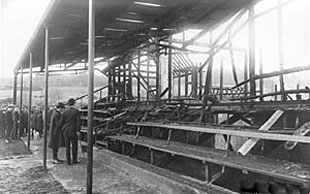|
|
|

The charred remains of the Tunbridge Wells pavilion
© Cricinfo
|
|
| |
The years leading up to World War One are remembered as cricket's Golden Age, an era of sunshine and swashbuckling strokeplay. It was also a period of unrest in England, with increasing social awareness, Labour emerging as a major party to challenge the old establishment, and women becoming vocal in their demands to be given the vote.
By 1913 the suffragette movement, which demanded enfranchisement for women, was becoming more militant after failing to force change by peaceful means, and protests had given way to civil disobedience and, in extreme instances, violence.
The number of attacks, ranging from vandalism to arson and bombings, was on the increase, escalating after the on-off imprisonment of Emmeline Pankhurst, who had founded the Women's Social and Political Union a decade earlier. At the forefront of the targets were
buildings and organisations seen to discriminate against women. Horse-racing was a prime target - it was in June 1913 that Emily Davidson threw herself under the King's horse during the Derby - as were golf and cricket, where women were largely prohibited from pavilions.
In the early hours of April 11, 1913, a street lamp lighter on his rounds noticed that the cricket pavilion at Tunbridge Wells' Nevill Ground was on fire. He alerted the police and the fire brigade, but by the time they arrived the largely wooden building was ablaze. It took an hour to extinguish the fire but all that remained were a few brick walls and a mass of charred timbers.
Firemen found a photograph of Pankhurst accompanied by a copy of a suffragette newspaper and an electric lamp lying on the turf in front of the wreck. The groundsman confirmed that the pavilion and ground had been locked and it soon became clear that whoever had set light to the building had scaled the high perimeter fence to gain access.
"There is no doubt the fire was a result of incendarism, presumably by the militant suffragettes," fumed the Tonbridge Free Press. "However, the police have not obtained the slightest clues to the perpetrators of this outrage." Nor would they find any. All they discovered was the fire had started in one of the dressing rooms where the tarred nets were stored.
Rumours spread round the town, and there were reports of bombs and more incendiary devices being found, although these all turned out to be false alarms. The news travelled far and wide and even made the New York Times.
This attack appears to have had quite the opposite effect than that intended, for it is clear from contemporary reports that the townsfolk responded with anger. At the end of the month the National League for Opposing Women's Suffrage, who reported a boom in membership after the fire, held a meeting in Tunbridge Wells that attracted a sizeable attendance and national interest.
The main speaker was Sir Arthur Conan Doyle, the renowned author, keen cricketer and a resident of the town. He lambasted the suffragettes as "female hooligans" and compared the attack on the pavilion with "blowing up a blind man and his dog". He concluded by predicting that women would "not get the vote within a generation". The war changed all that, and their enfranchisement came in 1918.
The meeting concluded with a vote of censure against the government for failing to keep law and order. On the same day Herbert Asquith, the prime minister, said he was too busy to meet with women's representatives.
Within hours of the fire, which destroyed the archives and scorebooks of Tunbridge Wells, the Bluemantles and the Post Office cricket clubs, a fund had been launched to raise £1200 for the rebuilding of a new pavilion. Special concerts were held at the local opera house and the seemingly wildly optimistic aim, to have the replacement ready in time for Kent's cricket week nine weeks later, was achieved with hours to spare.
Bibliography
A History of Tunbridge Wells CC 1882-1982 (TWCC 1982)
Is there an incident from the past you would like to know more about? Email us with your comments and suggestions. Martin Williamson is executive editor of Cricinfo

